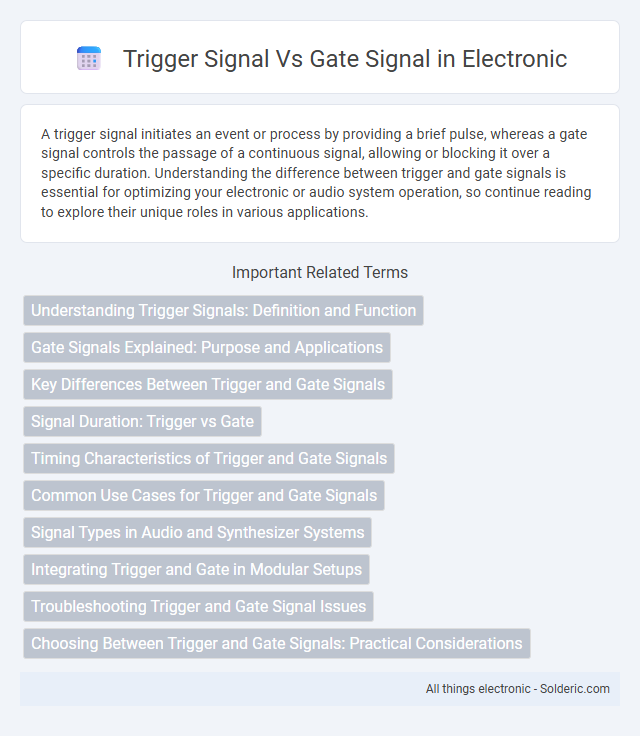A trigger signal initiates an event or process by providing a brief pulse, whereas a gate signal controls the passage of a continuous signal, allowing or blocking it over a specific duration. Understanding the difference between trigger and gate signals is essential for optimizing your electronic or audio system operation, so continue reading to explore their unique roles in various applications.
Comparison Table
| Aspect | Trigger Signal | Gate Signal |
|---|---|---|
| Definition | Short pulse to initiate an event or action | Continuous signal indicating an active timeframe |
| Duration | Brief, momentary | Extended, sustained |
| Function | Starts a process or event | Keeps a process or device enabled |
| Use Cases | Initiating a note in synthesizers, triggering timers | Holding notes, enabling modulators, controlling gate inputs |
| Signal Type | Pulse (digital, transient) | Level (digital, sustained high/low) |
| Example in Audio | Triggering drum hits | Gate controlling envelope generator |
Understanding Trigger Signals: Definition and Function
Trigger signals initiate specific actions within electronic systems by providing a precise, momentary pulse that activates circuits or devices. These signals differ from gate signals, which maintain a continuous on/off state to control the duration of an operation rather than just starting it. Understanding trigger signals involves recognizing their role in timing-sensitive applications such as oscillators, timers, and digital logic circuits, where exact activation timing is crucial for proper function.
Gate Signals Explained: Purpose and Applications
Gate signals control the duration of an electronic device's conduction period by remaining active as long as the signal is applied, making them essential in applications like thyristor regulation and power conversion. These signals enable precise modulation of power delivery, optimizing efficiency in systems such as motor drives and phase-controlled rectifiers. Unlike trigger signals, which provide a brief pulse to initiate conduction, gate signals sustain conduction, allowing continuous control over the load.
Key Differences Between Trigger and Gate Signals
Trigger signals are typically short pulses used to initiate or start an event in electronic circuits, commonly lasting only a few milliseconds. Gate signals, in contrast, are sustained signals that remain active for the duration of an event, controlling when a device, such as a synthesizer's envelope generator, is open or closed. The fundamental difference lies in trigger signals being momentary and edge-sensitive, while gate signals are level-sensitive and persistent throughout the action.
Signal Duration: Trigger vs Gate
Trigger signals generate a fixed-duration pulse regardless of input length, typically lasting a few milliseconds, used to initiate an event or envelope in synthesizers. Gate signals maintain the pulse for the entire duration of the key press or input, turning off only when released, enabling sustained notes or continuous sound modulation. Understanding signal duration differences is crucial for designing and controlling analog and digital synthesis workflows.
Timing Characteristics of Trigger and Gate Signals
Trigger signals initiate events with precise timing, offering fast rise times and short pulse widths to ensure accurate synchronization in electronic circuits. Gate signals control the duration of an event, maintaining a steady high or low state for extended periods compared to trigger signals, with slower transitions optimized for timing windows in devices like thyristors. The timing characteristics of trigger signals emphasize rapid response and edge precision, whereas gate signals prioritize stable duration and level maintenance to effectively regulate circuit operation.
Common Use Cases for Trigger and Gate Signals
Trigger signals, characterized by brief pulses, are commonly used for initiating events such as starting drum machines, triggering samplers, or resetting sequencers in music production. Gate signals, which maintain a voltage level for a specified duration, are typically employed to control note length in synthesizers, sustain envelopes, or modulate effects in analog and modular synthesis. Both signals are essential for precise timing and control in electronic music hardware and audio processing workflows.
Signal Types in Audio and Synthesizer Systems
Trigger signals in audio and synthesizer systems are short, transient pulses used to initiate events such as starting a drum sound or a sequence step; they typically last only a few milliseconds. Gate signals differ by providing a sustained voltage level that remains active for the duration of a note or effect, controlling elements like envelope generators or note length in synthesizers. Understanding the distinction between trigger and gate signals enhances your ability to design and troubleshoot timing and control functions in modular synth setups.
Integrating Trigger and Gate in Modular Setups
Integrating trigger and gate signals in modular synthesizer setups enhances control precision by combining the trigger's short pulse for event initiation with the gate's sustained voltage for note length. Utilizing trigger signals to initiate envelopes and gates to maintain them allows seamless interaction between rhythmic timing and tonal expression. This synergy optimizes performance dynamics and facilitates complex sequencing within modular environments.
Troubleshooting Trigger and Gate Signal Issues
Troubleshooting trigger and gate signal issues requires checking signal integrity with an oscilloscope to ensure proper voltage levels and timing consistency. Common problems include signal distortion, unexpected noise, and incorrect polarity, which can cause missed or false triggers in synthesizer circuits. Verifying cable connections, signal source settings, and module compatibility helps isolate and resolve issues affecting synchronization and response.
Choosing Between Trigger and Gate Signals: Practical Considerations
Choosing between trigger and gate signals depends on the desired behavior of the synthesizer or sequencer; trigger signals provide a short pulse to initiate an event, ideal for percussive sounds, while gate signals maintain a voltage level for the duration of a note, suitable for sustained tones. Practical considerations include the response time of the instrument, where triggers ensure precise note onset and gates allow for controlled note length and expression. Compatibility with the hardware or software interface is critical, as some devices exclusively support one signal type, influencing performance and sound design flexibility.
trigger signal vs gate signal Infographic

 solderic.com
solderic.com